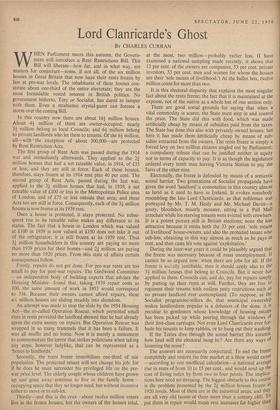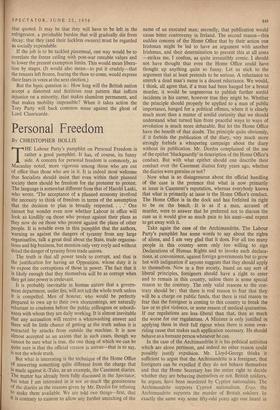Lord Clanricarde's Ghost
BY CHARLES CURRAN WHEN Parliament meets this autumn, the Govern- ment will introduce a Rent Restrictions Bill. This Bill will liberate--how far, and in what way, are matters for conjecture—some, if not all, of the six million houses in Great Britain that now have their rents frozen by law at pre-war levels. The inhabitants of these houses con- stitute about one-third of the entire electorate; they are the most formidable vested interest in British politics. No government hitherto, Tory or Socialist, has dared to tamper with them. Even a strabismic crystal-gazer can foresee a storm over the coming Bill.
In this country now there are about 145 million houses. About 45 million of them are owner-occupied; nearly 34 million belong to local Councils; and 65 million belong to private landlords who let them to tenants. Of the 65 million, all—with ' the exception of about 500,000—are protected by Rent Restriction Acts.
The first group of Rent Acts was passed during the 1914 war and immediately afterwards. They applied to the 4 million houses that had a net rateable value, in 1914, of £35 or less; and they are still in force. Each of these houses, therefore, stays frozen at its 1914 rent plus 40 per cent. The second group of Rent Acts, passed during the last war, applied to the 4 million houses that had, in 1939, a net rateable value of £100 or less in the Metropolitan Police area of London, and of £75 or less outside that area; and these Acts too are still in force. Consequently, each of the 31- million houses is now frozen at its 1939 rent.
Once a house is protected, it stays protected. No subse- quent rise in its rateable value makes any difference to its status. The fact that a house -in London which was valued at £100 in 1939 is now valued at £150 does not take it out of the refrigerator; it is still frozen at its 1939 rent. Thus 3* million householders in this country are paying no more than 1939 prices for their homes—and 4 million are paying no more than 1920 prices. From this state of affairs certain consequences follow.
Firstly, repairs do not get done. For pre-war rents are too small to pay for post-war repairs. The Girdwood Committee ---an independent body of building experts that advises the Housing Minister--found that, taking 1939 repair costs as 100, the same amount of work in 1953 would correspond to 316. Because their owners cannot afford repairs, these six million houses are sliding steadily into slumdom.
An attempt was made to stop the slide by the 1954 Housing Act—the so-called Operation Rescue, which permitted small, rises in rents provided the landlorpl showed that he had already spent-the extra money on repairs. But Operation Rescue was wrapped in so many trammels that it has been a failure. It was all snaffle and no horse. Now it is merely a monument to commemorate the terror that strikes politicians when taking any steps, however ladylike, that can be represented, as a `bonus to landlords.'
Secondly, the rents freeze immobilises one-third of our population. The protected tenant will not change his job; for if he does he must surrender his privileged life on the pre- war price level. The elderly couple whose children have grown up and gone away continue to live in the family home— occupying space that they no longer need, but without incentive either to move or to sub-let.
Thirdly—and this is the crux—about twelve million voters live in the frozen houses; but the owners of the houses total, at the most, two million—probably rather less. (I have examined a national sampling made recently; it shows that 13 per cent. of the owners are companies, 53 per cent. private investors, 33 per cent. men and women for whom the.houses are their 'sole means of livelihood.') At th,e ballot box, twelve million count for more than two.
It is this electoral disparity that explains the most singular fact about the rents freeze; the fact that it is maintained at the expense, not of the nation as a .whole but of one section only.
There are good social grounds for saying that when a vital commodity is scarce, the State, must step in and control the price. The State did this with food, which was made artificially cheap by means of subsidies paid from the taxes. The State has done this also with privately owned houses; but here it has made them artificially cheap by means of sub- sidies extracted from the owners. The rents freeze is simply a forced levy on two million citizens singled out by Parliament; a compulsory tribute that can be justified neither in equity nor in terms of capacity to pay. It is as though the legislature ordered every tenth man leaving Victoria Station to pay the fares of the other nine.
Electorally, the freeze is defended by means of a semantic sound barrier. Two generations of Socialist propaganda have given the word 'landlord' a connotation in this country almost as lurid as it used to have in Ireland. It evokes somebody resembling the late Lord Clanricarde, as that nobleman was portrayed by Mr. T. M. Healy and Mr. Michael Davitt—a gouty, bloodshot, miserly monster, sitting in a Pall Mall armchair while his starving tenants were evicted with crowbars. It is a potent picture still in British elections; none the less attractive because it omits both the 33 per cent. 'sole means of livelihood' house-owners, and also the protected tenant who sub-lets, obtaining in this way almost as much as he pays in rent, and then casts his vote against 'exploitation.' , During the inter-war years it could be plausibly argued that the freeze was necessary because of mass unemployment. It cannot be so argued now, when there are jobs for all. If the freeze is socially justifiable, then it should apply also to the 35 million houses that belong to Councils. But it never has applied to them. Councils can, and do, pay for repairs simply by putting up their rents at will. Further, they are free to regiment their tenants with endless petty restrictions such as no private landlord ever contemplated. (To suppose, as the Socialist' programme-sellers do, that municipal ownership makes landlordism popular is a delusion of the dons; it is peculiar to gentlemen whose knowledge of housing estates has been picked 'up while peering through the windows of their first-class carriages. Not even Lord Clanricarde ever for- bade his tenants to keep rabbits, or to hang out their washing.
If the Tories dive through the sound barrier this autumn, how loud will the electoral bang be?. Are there any ways of lessening the noise? The answers are necessarily conjectural. To end the freeze completely and restore the free market at a blow would cause —according to one unofficial calculation—a .national average rise in rents of from 10 to 15 per cent., and would send up the cost of living index by from two to four points. The impliea' tions here need no stressing. The biggest obstacle to this course is the problem presented by the million houses frozen at 1920 levels. Most of them are in the industrial areas, and they are all very old (some of them more than a century old). To put them in repair would mean rent increases far higher thaa that quoted. It may be that they W411 have to be left in the refrigerator, a perishable burden that will gradually die from decay; that they (and their luckless owners) must be regarded as socially expendable.
If the job is to be tackled piecemeal, one way would be to correlate the freeze ceiling with post-war rateable values and to lower the present exemption limits. This would mean libera- tion by stages. (It would also mean—to put it crudely—that the tenants left frozen, fearing the thaw to come, would express their fears in votes at the next election.) But the basic question is : How long will the British nation accept a distorted and fictitious rent pattern that inflicts injustice on a minority, that makes slumdom permanent, and that makes mobility impossible? When it takes action the Tory Party will back common sense against the ghost of Lord Clanricarde.



































 Previous page
Previous page